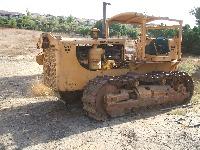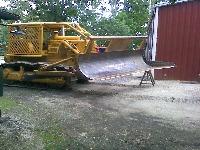- Posts: 721
- Thank you received: 0

ACMOC Membership Benefits
- FREE quarterly magazine filled with content about antique Caterpillar machines
- FREE classified listings
- ACMOC store discounts and specials
- Full Bulletin Board Access
- Marketplace (For Sale/Wanted)
- Technical Library
- Post attachments
$44 /year ELECTRONIC
$60 /year USA
$77 /year International
3 18a d9s for sale at auction
- Dozerman51
-

- Offline
- Platinum Boarder
- Member
Please Log in or Create an account to join the conversation.
Please Log in or Create an account to join the conversation.
- Garlic Pete
-

- Offline
- User is blocked
- User
- Posts: 2533
- Thank you received: 1
Once they got wise to that, they started specifying more and more destruction in their "Certified Destruction" instructions. If the owner wants to follow the destruction path, they do a pretty good job of making sure that machine is economically unrepairable and most of the time, they want to ensure that the significant parts are not useable for repair of another older machine. These surprised me because from what I've seen in our area, they pretty much require the largest dimension of the largest intact piece of the machine to be less than four feet. That means the tracks have to get cut, frames, everything. About all you can save and resell is the knobs and some small stuff.
The destruction can't be done by the owner, it has to be done by one of a few approved vendors, mostly scrapyards. When the machine is presented for acceptance into the program, the air board inspector visits the owners yard and verifies that it starts and moves a bit forward and back under its own power. Prior to that, the owner can have stripped off anything he wants. As long as the machine is fundamentally complete (has all the tires, even if they're flat and bald, etc.), starts briefly and will move a few inches forward and back, it can be accepted.
Once accepted, the owner moves it to the certified destruction scrapyard. There, they follow the destruction guidelines, photograph the start, progress and completion of the process, including all the serial number tags several times during the process. The owner then files the photos and certificate with the air board, places the purchase order with the dealer for the replacement machines and the air board funds the reimbursement to the dealer.
I suspect that these were much more gently handled because I'll bet the air board had to relax their destruction standards because of the price of scrap. They probably couldn't get certified destruction vendors to participate because they'd lose money processing the destruction because the remaining value of the scrap wouldn't cover the cost of processing.
Someone could get some very nice undercarriage, and probably some other really nice parts, looking at these machines. Depending what else was done, they almost look like they could be resurrected.
By the way, destruction isn't the only way these machines could be handled. Permanent removal and sale outside the air basin is another option. This participant could have sold these tractors to someone in Nevada, Arizona, Oregon or anywhere outside the central Valley and South Coast area and gotten the same reimbursement. Sales outside the basin don't often happen though, especially for machines of this size because of the economics of selling and transporting the machine. They just don't have enough utility left to justify the transport costs.
I did try with several machines I thought were interesting to convince the air board to allow retirement in place, with the machine relegated to hobby and history preservation status. No dice, if it could run and generate pollution and remained in the air basin, it wouldn't qualify.
Pete.
Please Log in or Create an account to join the conversation.
A few years ago I decided to go to a board meeting and public comment meeting at the Air Resource Board in Sacramento, Ca. I was shocked as I walked up to the building...first I heard young kids voices shouting out. Hmmmm child care facility for the Boards employees right at work... Then I was floored by the size of the dominos in the landscaping. Huge granite shapes like 12' wide must have been 20' tall and buried into the ground. I looked and wondered of the price tag of this entry way to the building... Must have been $10 million in hard scaping stone work at least... Then I walked into the lobby and saw stainless steel every where. Waterfalls streaming down the walls... Holy Crap... I walked to the auditorium hearing area and sat in some of the most plush seats ever for a public hearing... OMG... all our tax dollars at work. I was amazed at the size of the staff at the hearing. I went home and looked up a staff by name directory and started counting. I stayed up for hours floored in front of a computer thinking of all the retirements and perks we must pay. I got through the "A's, B's, and Half Way into the C's"!!! I counted over 350 employees and rising... There are 1000's and 1000's of them that we must provide a comfortable living for, daycare too. OMG...They have nothing to do but make rules that control us, costing us millions of dollars... but we will be healthier. I think, No, I wonder... are they keeping count on how many lives have been lost to these PDF mufflers catching Fire. A truck driver just lost his life in a fire in my local area a couple of months ago. How about the truck in a blazing fire that crossed over I-5 and crashed into two bus loads of high school kids on a school outing. They think the PDF caused the fire. Ask the widows, and Parents of the deceased if they feel healthier. Thanks CARB... your doing a fine job!!!
www.calepa.ca.gov/EPABldg/PublicArt.htm
Please Log in or Create an account to join the conversation.
Please Log in or Create an account to join the conversation.
Please Log in or Create an account to join the conversation.
Please Log in or Create an account to join the conversation.
You can't move them until you do some major splicing and welding. It's a shame... You need to do major work just to move them off the pallets, then haul dead weight away. It will cost more in transportation and patching than you can get for scrap. It's a shame. The hole in blocks were cut down and thru the flange for oil pans. You want to cry when you see what they did...
Please Log in or Create an account to join the conversation.
Since they were cheaper than scrap price, only two hours away, and I own a Heavy Haul, I saved all 3 of them. If anyone is interested in great tracks and undercarriage parts, contact me...
Glen
Please Log in or Create an account to join the conversation.
- janmeermans
-

- Offline
- Moderator
- Member
- Posts: 1946
- Thank you received: 43
Somehow I am not surprised that you grabbed these. Now you can set up a "Flashing Blue Light Special" on D9 parts down by the Petaluma River! Too bad these part don't cross over to 14As. Good going Glen!
Jan
PS- Did they throw in the pallets for good measure?
Please Log in or Create an account to join the conversation.
ACMOC
Antique Caterpillar Machinery Owners Club
1115 Madison St NE # 1117
Salem, OR 97301
support@acmoc.org
"I became a member recently because the wealth of knowledge here is priceless."
- Chris R
"I also joined a year ago. had been on here a couple of times as a non-member and found the info very helpful so I got a one year subscription (not very expensive at all) to try it out. I really like all the resources on here so I just got a three year. I think its a very small price for what you can get out of this site."
- Jason N


